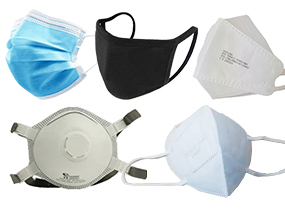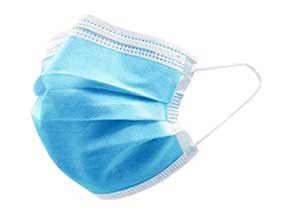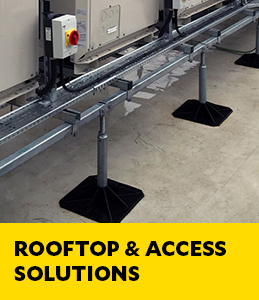The Kernow-How on Face Masks & Face Coverings
Posted on 27-07-2020
 Never before have we heard so much about face masks and face coverings and there are so many available options. But do we really know which type of face mask we should be wearing? Well that really depends on the intended use and environment. They really fall into 3 main categories:
Never before have we heard so much about face masks and face coverings and there are so many available options. But do we really know which type of face mask we should be wearing? Well that really depends on the intended use and environment. They really fall into 3 main categories:
• Face Coverings
• Face Masks – Surgical (Medical Device)
• Face Masks – Respirator (PPE)
Face Coverings
 Face coverings safely cover both the mouth and nose to help prevent the spread of infection such as coronavirus (Covid-19) through escaping droplets. They are intended for general public use for the protection of others rather than the person wearing it. They are normally made of comfortable breathable materials such as cotton and generally have a minimum of two layers. They are not classed as PPE (Personal Protective Equipment) as they don’t provide protection against work risks and hazards such as dust and spray.
Face coverings safely cover both the mouth and nose to help prevent the spread of infection such as coronavirus (Covid-19) through escaping droplets. They are intended for general public use for the protection of others rather than the person wearing it. They are normally made of comfortable breathable materials such as cotton and generally have a minimum of two layers. They are not classed as PPE (Personal Protective Equipment) as they don’t provide protection against work risks and hazards such as dust and spray.
Face coverings are not generally recognised by any UK standards. The UK Government states that latest evidence suggests a face covering of thicker fabric or multiple layers may reduce the risk of transmission. However, it’s advised that face coverings should also be used in conjunction with other preventative measures such as social distancing, washing or sanitising hands regularly, using screens and barriers etc.
The great benefit of fabric face coverings is that they are usually washable and reusable, therefore more economical.
Face Masks
Unlike face coverings, face masks are regulated and will be covered by different standards depending on the intended purpose. They may be considered as Personal Protective Equipment (PPE) or Medical Devices, and in some cases they can actually be considered as both.
Surgical Face Masks (Class 1 Medical Devices)
Surgical face masks are Class 1 Medical Devices, originally designed for use in a medical environment. These 3 ply traditional style masks are often worn by frontline staff such as dentists, hospital workers and care workers. They are intended for use by healthcare staff to help protect patients in a medical environment, not to protect the wearer from airborne diseases. They are tested in exhalation (inside to outside) and take into account the bacterial filtration efficiency, of which there are 3 levels (BFE1, BFE2, Type R). Type I has a 95% filtration level while Type II and Type IIR have a 98% filtration level.

|
Surgical Face Mask
|
Bacterial Filtration Efficiency
|
Splash Protection
|
|
TYPE I – Standard Civilian
|
95%
|
N/A
|
|
TYPE II (EN 14683)
|
98%
|
N/A
|
|
TYPE IIR – Medical Grade (EN 14683)
|
98%
|
Splash Resistant
|
Type II face masks, covered by EN 14683, have a protective 3 ply pleated construction that stops large particles escaping the wearer. The Type IIR also has a splash resistant layer that protects against bodily fluids. Medical masks in Europe will meet the design and safety requirements of the Medical Device Regulations (MDD/MDR) and be CE marked. All types of surgical face masks are intended to prevent the wearer from transmitting infection and protecting others. Medical masks are lightweight so fairly comfortable and are disposable with a one-time use.
Respirators (PPE)
When a face mask is intended for personal protection of the wearer, it is classed as Personal Protective Equipment (PPE) and will have to meet the standards set out by regulations covering PPE. Respiratory Protective Equipment in Europe must meet European standard EN149: 2001, which includes three classes of disposable particulate respirators (FFP1, FFP2 and FFP3) according to their filtering capabilities. The higher the number, the higher the filtration efficiency. These Filtering Face Pieces (FFPs) are tested on the direction of inhalation (outside to inside), the opposite way to surgical face masks, as well as tested for leakage.
These filtering half masks are designed to protect against solids (such as dust and particles), water-based aerosols, and oil-based aerosols. It will be entirely or substantially constructed of filter material. Each mask will have an Assigned Protection Factor (APF) which indicates the factor by which the wearer is protected from hazardous substances. For example, a mask with an APF of 4 will reduce the hazard to the wearer by 4 times.
|
Filtering Face Piece (FFP)
|
Minimum Filtration %
|
Assigned Protection Factor (APF)
|
|
FFP1
|
80%
|
APF 4
|
|
FFP2
|
94%
|
APF10
|
|
FFP3
|
99%
|
APF 20
|
FFP1
The FFP1 is the most basic respirator and can protect the wearer from non-toxic substances such as brick dust, cement, lime dust and pollen but does not provide a high enough protection against toxic substances (with an inward leakage of 22%). Usually the FFP1 is used for protection during DIY tasks such as sanding.
Minimum Filtration: 80% APF:4
FFP2
The FFP2 mask is the equivalent of the US N95 standard and the Chinese KN95 standard which meet the WHO guidelines for protection against infectious diseases such as Covid-19. FFP2 masks have a minimum of 94% filtration and a maximum of 8% leakage to the inside. It offers a more moderate protection against harmful airborne substances including lead dust, granite dust, softwood dust, smoke and aerosols. It’s often used in mining, metal and construction industries, agriculture and for healthcare professionals to protect against influenza.

Minimum Filtration: 94% APF:10
FFP3
FFP3 masks provide the highest level of breathing protection against harmful pollutants and must provide a minimum of 99% filtration and a maximum 2% leakage to the inside. It protects against a variety of fine toxic particles including asbestos, bacteria and viruses. The NHS guidelines stipulate the use of FFP3 face masks for virus and bacterial control when it is spread through coughing and sneezing (such as Covid-19). They are often used by healthcare professionals when handling hazardous pharmaceutical chemicals too.
Normally FFP3s are better shaped to fit the face and typically include a valve to help breathe as the filtration material is so thick. This can also help to reduce moisture build-up, lengthening the lifespan of the mask.
Minimum Filtration: 99% APF: 20
FFP2, FFP3, KN95 and other respirator masks are effective at protecting the wearer from viral transmission such as Covid-19. Although the KN95 is an equivalent which meets the WHO guidelines for protection against infectious diseases, it is not yet covered by EN regulation and therefore can’t legally be recommended as a direct equivalent for use in Europe. However, due to recent demand and shortages it has become a popular alternative.
Choosing the Right Option
Whether it relates to Covid-19, DIY or the construction industry, choosing the right face covering or face mask is vital for the adequate protection of the wearer or others. Consideration of the intended use, who the mask or covering is there to protect and the environment it will be worn in, will indicate which solution is required. Remember, the wrong protection is no protection at all! Kernow stocks a range of face coverings, masks and PPE suitable for a variety of needs, from reusable fabric face coverings to respirators. Get in touch if we can help you with your requirements.
Further information
Government Links:
Do I have to wear a face covering in public? (see section 3.16. Updated 22/09/20)
When to Wear Face Coverings
Working Safely During Covid-19 – Construction & Other Outdoor Work
Regulatory status of equipment being used to help prevent coronavirus (COVID-19)
Guidance on Class 1 Medical Devices
HSE Links:
Using PPE at Work During the Coronavirus Pandemic
Protection Afforded by Surgical Face Masks Against Influenza
Dental Nursing Journal – Covid-19: A Guide to Face Masks
Quick Quote

 Never before have we heard so much about face masks and face coverings and there are so many available options. But do we really know which type of face mask we should be wearing? Well that really depends on the intended use and environment. They really fall into 3 main categories:
Never before have we heard so much about face masks and face coverings and there are so many available options. But do we really know which type of face mask we should be wearing? Well that really depends on the intended use and environment. They really fall into 3 main categories:  Face coverings safely cover both the mouth and nose to help prevent the spread of infection such as coronavirus (Covid-19) through escaping droplets. They are intended for general public use for the protection of others rather than the person wearing it. They are normally made of comfortable breathable materials such as cotton and generally have a minimum of two layers. They are not classed as PPE (Personal Protective Equipment) as they don’t provide protection against work risks and hazards such as dust and spray.
Face coverings safely cover both the mouth and nose to help prevent the spread of infection such as coronavirus (Covid-19) through escaping droplets. They are intended for general public use for the protection of others rather than the person wearing it. They are normally made of comfortable breathable materials such as cotton and generally have a minimum of two layers. They are not classed as PPE (Personal Protective Equipment) as they don’t provide protection against work risks and hazards such as dust and spray. 



